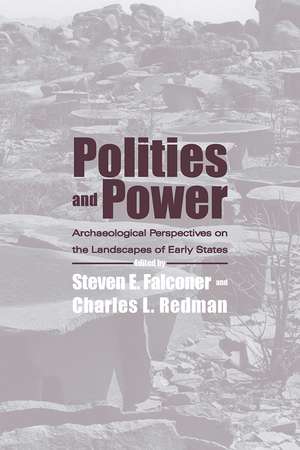Polities and Power: Archaeological Perspectives on the Landscapes of Early States
Editat de Steven E. Falconer, Charles L. Redmanen Limba Engleză Hardback – 15 dec 2009
This distinctive book is the first to address the topic of landscape archaeology in early states from a truly global perspective. It provides an excellent introduction to—and overview of—the discipline today. The volume grew out of the Fifth Biennial Meeting of the Complex Societies Group, whose theme, States and the Landscape, paid tribute to the work of Robert McC. Adams. When Adams began publishing in the 1960s, the interdependence of cities and their countrysides, and the information revealed through the spatial patterning of communities, went largely unrecognized. Today, as this useful collection makes clear, these interpretive insights are fundamental to all archaeologists who investigate the roles of complex polities in their landscapes.
Polities and Power features detailed studies from an intentionally disparate array of regions, including Mesoamerica, Andean South America, southwestern Asia, East Africa, and the Indian subcontinent. Each chapter or pair of chapters is followed by a critical commentary. In concert, these studies strive to infer social, political, and economic meaning from archaeologically discerned landscapes associated with societies that incorporate some expression of state authority. The contributions engage a variety of themes, including the significance of landscapes as they condition and reflect complex polities; the interplay of natural and cultural elements in defining landscapes of state; archaeological landscapes as ever-dynamic entities; and archaeological landscapes as recursive structures, reflected in palimpsests of human activity.
Individually, many of these contributions are provocative, even controversial. Taken together, they reveal the contours of landscape archaeology at this particular evolutionary moment.
Polities and Power features detailed studies from an intentionally disparate array of regions, including Mesoamerica, Andean South America, southwestern Asia, East Africa, and the Indian subcontinent. Each chapter or pair of chapters is followed by a critical commentary. In concert, these studies strive to infer social, political, and economic meaning from archaeologically discerned landscapes associated with societies that incorporate some expression of state authority. The contributions engage a variety of themes, including the significance of landscapes as they condition and reflect complex polities; the interplay of natural and cultural elements in defining landscapes of state; archaeological landscapes as ever-dynamic entities; and archaeological landscapes as recursive structures, reflected in palimpsests of human activity.
Individually, many of these contributions are provocative, even controversial. Taken together, they reveal the contours of landscape archaeology at this particular evolutionary moment.
Preț: 380.26 lei
Preț vechi: 562.32 lei
-32% Nou
Puncte Express: 570
Preț estimativ în valută:
72.76€ • 76.13$ • 60.44£
72.76€ • 76.13$ • 60.44£
Carte indisponibilă temporar
Doresc să fiu notificat când acest titlu va fi disponibil:
Se trimite...
Preluare comenzi: 021 569.72.76
Specificații
ISBN-13: 9780816526031
ISBN-10: 0816526036
Pagini: 256
Dimensiuni: 152 x 229 x 23 mm
Greutate: 0.57 kg
Ediția:2
Editura: University of Arizona Press
Colecția University of Arizona Press
ISBN-10: 0816526036
Pagini: 256
Dimensiuni: 152 x 229 x 23 mm
Greutate: 0.57 kg
Ediția:2
Editura: University of Arizona Press
Colecția University of Arizona Press
Notă biografică
Steven E. Falconer is a professor of archaeology in the School of Human Evolution and Social Change at Arizona State University. Charles L. Redman is Professor and Director of the Center for Environmental Studies, Arizona State University.
Cuprins
Preface vii
1 The Archaeology of Early States and Their Landscapes
Steven E. Falconer and Charles L. Redman
2 Changing Cultural Landscapes of the Tungabhadra Valley, South India
Carla M. Sinopoli, Peter Johansen, and Kathleen D. Morrison
3 Marking Landscapes: The Tungabhadra Project from History to Prehistory
Rita P. Wright
4 Agriculture as Metaphor of the Andean State
Christine A. Hastorf
5 Metaphor, Monumentality, and Memory: The Imagery of Power on the Ancient Landscape
Katharina Schreiber
6 Landscape and the Tarascan State: Labor, Intensification, and Land Degradation
Christopher T. Fisher
7 Tarascan Land Degradation and Alternative Traditions in Americanist Landscape Archaeology
Arthur A. Joyce
8 States, Landscapes, and the Urban Process in Upper Mesopotamia: Inter-Polity Alliances, Competition, and Ritualized Exchange
Patricia Wattenmaker
9 The Bronze Age Political Landscape of the Southern Levant
Steven E. Falconer and Stephen H. Savage
10 Political Landscapes and States in Upper Mesopotamia and the Levant
T. J. Wilkinson
11 Landscape at Two Scales: Economy and Trade in East Africa
Chapurukha M. Kusimba
12 Agency, Dependency, and Long-Distance Trade: East Africa and the Islamic World, ca. 700–1500 CE
David Killick
13 African Archaeology in World Perspective
Peter Robertshaw
Bibliography
About the Editors
About the Contributors
Index
1 The Archaeology of Early States and Their Landscapes
Steven E. Falconer and Charles L. Redman
2 Changing Cultural Landscapes of the Tungabhadra Valley, South India
Carla M. Sinopoli, Peter Johansen, and Kathleen D. Morrison
3 Marking Landscapes: The Tungabhadra Project from History to Prehistory
Rita P. Wright
4 Agriculture as Metaphor of the Andean State
Christine A. Hastorf
5 Metaphor, Monumentality, and Memory: The Imagery of Power on the Ancient Landscape
Katharina Schreiber
6 Landscape and the Tarascan State: Labor, Intensification, and Land Degradation
Christopher T. Fisher
7 Tarascan Land Degradation and Alternative Traditions in Americanist Landscape Archaeology
Arthur A. Joyce
8 States, Landscapes, and the Urban Process in Upper Mesopotamia: Inter-Polity Alliances, Competition, and Ritualized Exchange
Patricia Wattenmaker
9 The Bronze Age Political Landscape of the Southern Levant
Steven E. Falconer and Stephen H. Savage
10 Political Landscapes and States in Upper Mesopotamia and the Levant
T. J. Wilkinson
11 Landscape at Two Scales: Economy and Trade in East Africa
Chapurukha M. Kusimba
12 Agency, Dependency, and Long-Distance Trade: East Africa and the Islamic World, ca. 700–1500 CE
David Killick
13 African Archaeology in World Perspective
Peter Robertshaw
Bibliography
About the Editors
About the Contributors
Index
Recenzii
“The explicit attention to several significant emerging themes in the study of archaeological landscapes makes this volume timely and indicative of the future direction of such studies.” —Jason Ur, Harvard University
